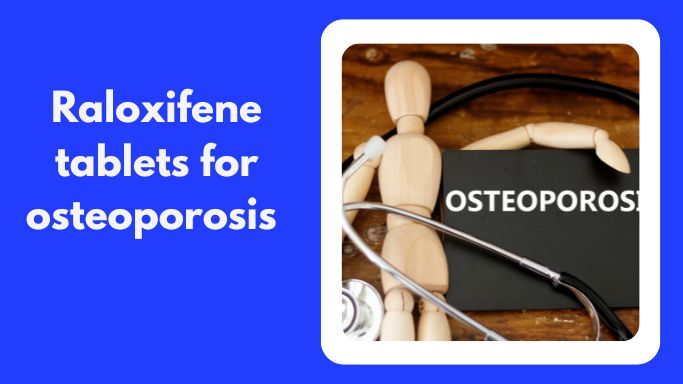Raloxifene tablets for osteoporosis let us discuss one of the drugs, Loxic, Phaed. Breast cancer is one of the condition which is widely observed in both premenopausal as well as postmenopausal women.
The proliferation of breast tissue is mainly due to the enhanced activity of estrogen. Many drugs are used to treat the breast cancer. And among them, few of the drugs are directly inhibiting the estrogenic activity, whereby they reduce the breast cancer. For instance, we have drugs like d imoxyphene, which can be used in the treatment of breast cancer, both in premenopausal as well as postmenopausal women.
Another drug with similar suffix is the reloxyphene, belonging to the same category. And chromophene is another drug between this category. But chromophene is mainly intended to induce the ovulation in an oovulatory women. Similarly, reloxyphene can be used in the treatment of breast cancer in postmenopausal women only. So even these three drugs are belonging to the same category.
Read More: Tacrolimus ointment for atopic dermatitis
They are having the different clinical indications. Tamoxicin can be used in the treatment of breast cancer in both premenopausal as well as postmenopausal women. Whereas ranoxicin is only useful in the postmenopausal women. And clonoxicin is completely different.
It can be used in use of ovulation in an o ovulatory women. Even these three drugs are hang the different clinical indications. But all these three drugs belong to the same category that is SDRM, Selective Estrogen Receptor Modulators.
we are going to discuss about the raloxafene, which is a Selective Estrogen Receptor Modulator. Now, this reloxyphene can be used in the treatment of breast cancer, which is invasive in nature. That means it is highly spreading. In such conditions, reloxyphene can be used to reduce the risk of invasive breast cancer.
Raloxifene tablets for osteoporosis
But the main clinical indication of this drug is in the treatment of o rchoporosis in postmenopausal women. Since reloxyphene can act as both agonist as well as antagonist on estrogen receptor, it can be used in the treatment of osteoporosis as well as the management of invasive breast cancer in postmenopausal women. So today in this, we are going to see how this drug acts, what is its chemical nature, what are the important precautions, side effects, dosage, all these things we will discuss in this . First of all, let us see the chemical nature of this treatment. So this is the structure of phthaloxic team.
Here we can observe the bingzothiocaine moiety with some side changes. Let us give the naming for this structure. This Benzothiopin is attached with a Ketone group at the third position. So we can write this as 1 dash Benzothiopin 3I. And at the sixth position, it is the hydroxy group, so 6 hydroxy. And at the second position, it is in the para hydroxy phthalate hydroxy phenyl group. So 2 4 hydroxy phthalate.
This N10 group is attached immediately to a Ketone group. Now to this Ketone on the other side, we can observe phenyl group. We can write this as phenyl. And this phenyl group is having a etoxic chain at the fourth position. So 4 etoxy. And this etoxy group is attached with a piper adenine ring system at the second carbon, so 2′ p iper adinine 1I.
That is the complete name of reloxyphene. Reloxyphene is a SCRM, which is a Benzothiopine delivery. Now, let us see how this drug acts. Phyloxepine can act as agonist as well as antagonist. It acts as a agonist on bones so that it can reduce the atherosclerosis by increase the estrogenic activity. It also acts as an antagonist on the breast tissue.
Now, Rhaloxyphean can act on the bones, which increase the archaeo blast activity and reduce the archaeo blast activity. Eustachary receptor are present within the cytoplasm, which are attached with one of the proteins which is P90, heat shock protein 90. These receptors are going to target the DNA within the nucleus.
So raloxyphean can bind to the estrogen receptors, which are activated and undergo conformational change. Immediately, they are going to be internalized within the nucleus where they are undergoing the time regulation. And then they are going to interact with the DNA at a particular region which is response to the raloxyphean. So it can be called as reloxyphene response to LMA.
This DNA region is going to be interact with the estrogen receptor leading to gene transcription. And this gene transcription results in the development of mRNA. This mRNA results in the protein synthesis. Finally, reloxyphene can induce the protein synthesis, which reduce the archaeoporosis. It can induce the expression of alkoine fastidate enzyme.
It can also increase the expression of osteocalcin. Even it can increase the collagen synthesis. All these proteins can increase the arteroblast activity, and they can reduce the arteroblast activity. So this reduce the archaeoporosis in postmenopausal women.
Similarly, reloxyphene can act as antagonist on the estrogen receptors within the breast tissue, whereby it can reduce the proliferation and reduce the invasiveness of breast cancer in postmenopausal women. Now, let us the precautions of this drug. One of the important precautions of ranoxifin is that this drug can increase the risk of BVT.
It is also called as BVT or BVN thrombosis. It is one of the important limitation of the alloxyphene, which should be carefully monitored because this BVT may lead to pulmonary embolism. In the patients with any risk of thrombosis and pulmonary embolism, this drug should be carefully given. And particularly, this effect can be observed after four months of the treatment.
Any development of deep in thrombosis or pulmonary embolism should be carefully checked with the reloxidine after four months of the treatment. Few of the factors can also increase the deep in thrombosis. For instance, in the patients with post surgical recovery, they are highly immobilized and they stay most of the time on the bed, which further increase the thrombotic events. In such conditions, reloxifene can further increased the deep f in thrombosis. That’s why during the surgery, realloxyphene treatment should be stopped in order to reduce the risk of severe deep f in thrombosis.
Similarly, the premenopausal women, realloxyphene is somewhat ineffective. That’s why this drug is not indicated for the treatment of osteoporosis in premenopausal women as well as in the treatment of breast cancer in premenopausal women. This drug is only effective in postmenopausal women. Raloxifene is having the estrogenic activity and estrogen supplements are also increase the estrogenic activity.
But these two drugs should not be combined because this combination is unsafe as Phthaloxyphene is having both agonist as well as antagonist activity on the estrogen. So this combination is unsafe and they should not be combined. Similarly, this drug can increase the risk of stroke in the patient.
It cannot increase the embolism and thrombus formation. That’s why this drug should not be given to the patient with any cardiovascular disease. In such patients, this drug should not be given and it should not be used to prevent any cardiovascular disease. Similarly, ranoxafene is not indicated in the pregnant women.
So pregnant women or women liable to pregnant, this Raloxifene should not be given as it produce some fecal toxid. And this drug is only intended for the women and it is not used in the men. Now, let us see the side effects of the Loxid DMA.
This drug produce heart pressures which is commonly observed with many of the hormonal supplements. It can produce some leg cramps, arthritis, joint pain. It can also produce peripheral edema. Filling of legs can be observed, and excessive threading can be observed because of, again, estrogenic activity.
It can also produce tulic symptoms resulting in rhinitis, sinusitis. All these side effects are observed with VL of 50. How it is given? This drug is available as a tablet and it can be given at a dose of 6 Png given as once daily.
This drug can be taken with full or without full. It is not related with any full intake. At any time, it can be taken as 6 Png once a daily tablet. That’s about this drug, Rhaloxypine, which is a SCRM, Selective Estrogen Receptor Modulator.
This drug can be used in the treatment of osteoporosis as well as to reduce the risk of invasive breast cancer in postmenopausal women. But this drug is not effective in the premenopausal women. And this drug should be carefully given because it can increase the deep in thrombosis and pulmonary embolism. And you can test that you have the cardiovascular evenings.




